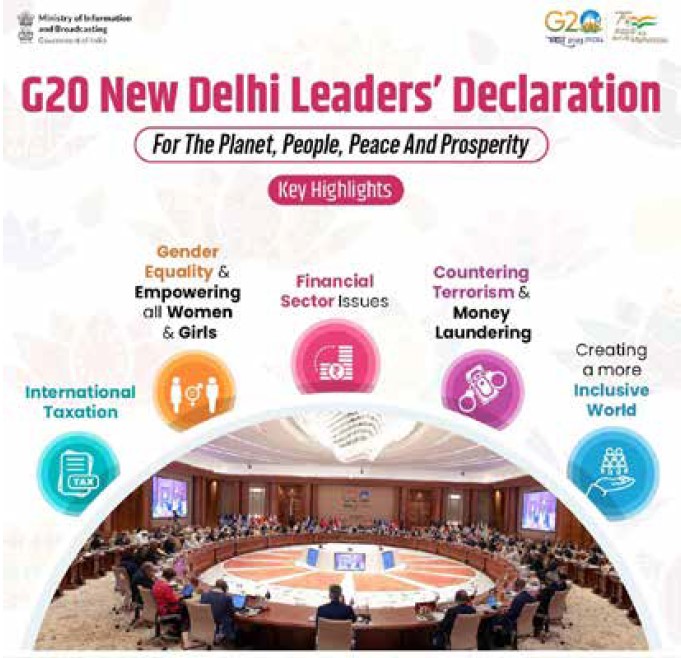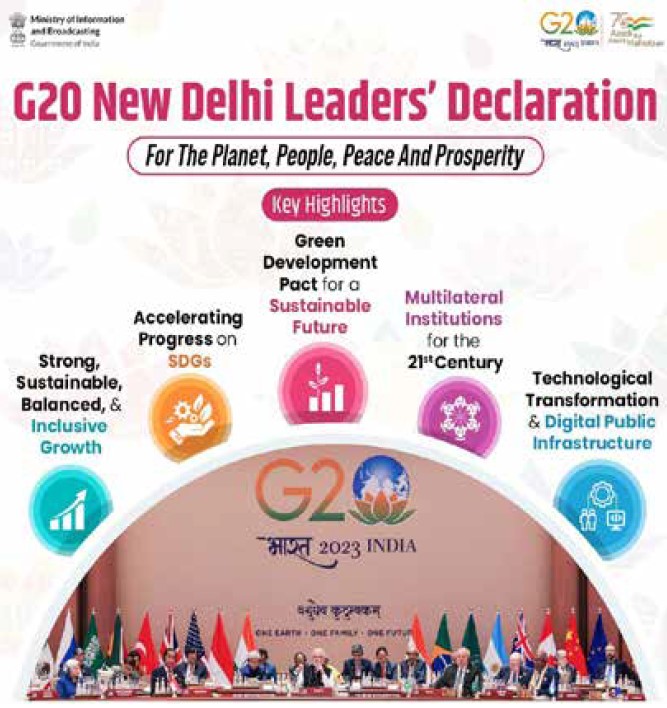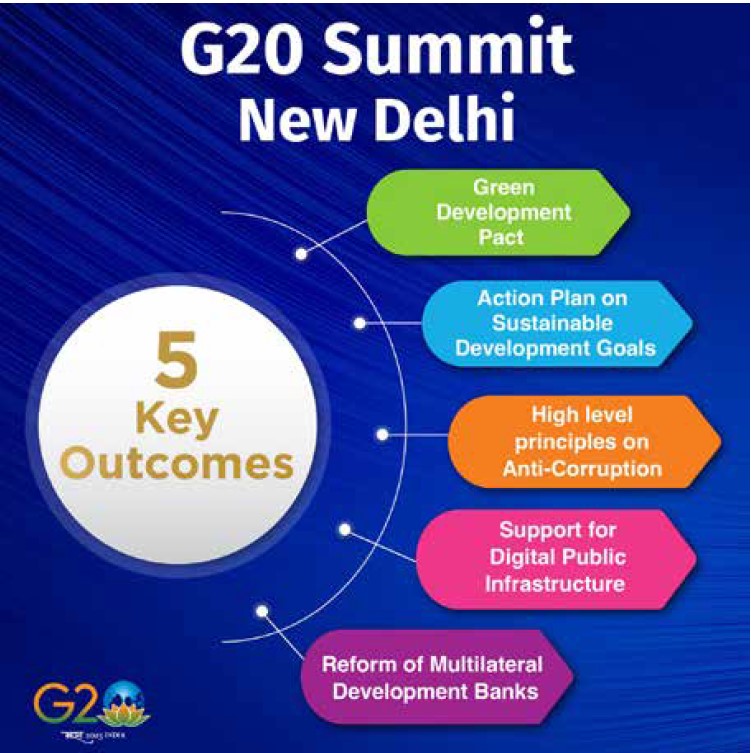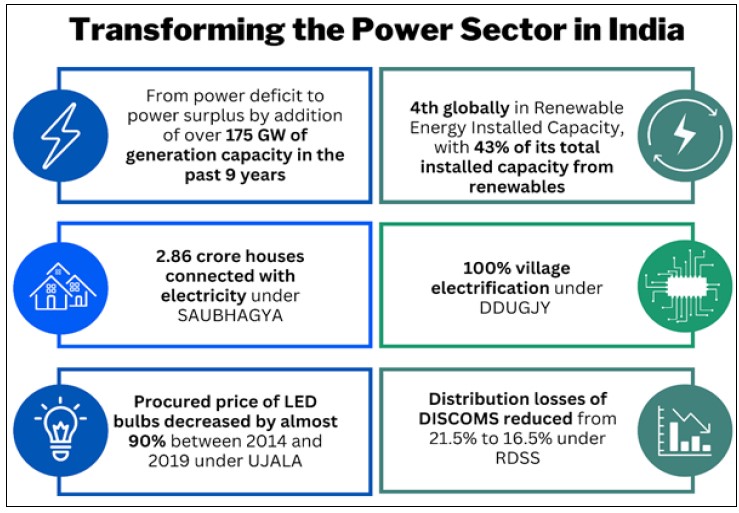YOJANA October 2023
Chapter 1- G20 for the Planet, People, Peace and Prosperity
- India’s G20 Presidency is a landmark, successfully championing both the climate and development agendas, and recognizing that countries should not have to choose between poverty alleviation and environmental protection.
- New Delhi Leaders’ Declaration (NDLD) was signed comprising 83 paragraphs, with no voice of dissent.
- This remarkable document signifies a momentous global consensus, underscoring the power of unity in addressing common challenges.
- The New Delhi Leaders’ Declaration represents a fundamental shift in focus, from conflict and division to development and cooperation.
- It showcases India as a global leader dedicated to enhancing policy and regulatory coherence among G20 countries, fostering more predictable and reliable trade, investment, and supply chains, while pushing the ambitions of climate action and inclusive development.


Accelerating Progress on the SDGs
- The latest UN SDG Report reveals that only 12% of SDG targets are on track, while 30% have stagnated or regressed since 2015.
- Post-Covid recovery poses additional challenges, with global economic conditions marked by high inflation, tight monetary policies, restrictive credit, and mounting debt distress in many developing nations.
- The endorsement of G20 Principles on harnessing Data for Development (D4D) reinforces the commitment.
- Additionally, the G20 Deccan High-Level Principles (HLPs) on Food Security and Nutrition 2023, along with the promotion of ancient grains like millets, hold the promise of ensuring global food and nutritional security—an essential aspect of sustainable development.
- India’s G20 presidency has established a Global Initiative on Digital Health to address evolving health challenges.
- India’s approach resonated with philosophies emphasizing harmony with the Earth, sustainable growth, and inclusivity.
- The ‘G20 2023 Action Plan to Accelerate Progress on the SDGs’ is a milestone achievement, promoting equitable, strong, sustainable, and inclusive economic growth while addressing challenges like access to finance and technology.
Green Development Pact, Climate Finance, and Mission LiFE
- India’s New Delhi Leaders’ Declaration (NDLD) includes the ‘Green Development Pact’– a comprehensive roadmap for the next decade to address the environmental crisis through global cooperation.
- G20 leaders pledge to pursue environmentally sustainable and inclusive economic growth and development in an integrated and balanced manner, benefiting the Global South.
- They call upon all countries to align their Nationally Determined Contributions (NDCs) with the Paris Agreement’s temperature goals and encourage economy-wide greenhouse gas (GHG) reduction targets in future NDC cycles.
| Paris Agreement- The Paris Agreement came into effect on November 4, 2016, after being approved by 196 nations at the UNFCCC Conference of the Parties (COP 21) in Paris on December 12, 2015. The agreement aims to cut and lessen greenhouse gas emissions. |
- G20 has agreed to High-Level Principles (HLPs) on hydrogen, critical mineral collaboration, a global biofuels alliance, and efforts to triple renewable energy capacity, among other initiatives.
- The NDLD emphasizes the role of healthy ecosystems in addressing climate change, biodiversity loss, and pollution, with a strong message on ending plastic pollution and promoting the circular economy.
- LiFE (Lifestyle for Environment) is India’s unique offering to transform India’s traditional, sustainable practices, and philosophical ethos into a scalable, global movement that changes the way societies consume and produce.
- The declaration urges nations to set an ambitious, transparent, and trackable New Collective Quantified Goal (NCQG) of climate finance by 2024, starting at £100 billion, and advocates for doubling collective adaptation finance compared to 2019 levels by 2025.
- For financing, G20 emphasises the importance of better, larger, and more effective Multilateral Development Banks (MDBs) and explores measures such as currency exchange guarantees and disaster clauses in debt repayment agreements to create a more responsive international development finance system.
- Through the collaborative efforts of the One Future Alliance, we are extending support to Low and Middle-Income Countries (LMICs), providing both capacity-building and financial assistance to foster the growth of their DPI systems.
Gender Equality and Empowering All Women and Girls- G20’s commitment to women empowerment is exemplified by the establishment of the Women’s Working Group, the first meeting of which is set to take place during the Brazilian Presidency.
The Voice of the Global South
- India’s advocacy was a visionary proposal–the inclusion of the African Union (AU) as a permanent member of the G20.
- India advocated for the AU’s permanent seat at the G20 table.
- India is also taking proactive steps to elevate the voices of African nations within the forum.
- A pivotal moment in India’s G20 presidency was the ‘Voice of the Global South Summit.’
- This landmark event, held earlier in the year, witnessed the gathering of 125 countries and the participation of 18 Heads of State from the Global South.
- India’s entire G20 Presidency placed a strong emphasis on issues such as Multilateral Development Banks (MDB) reform, digital public infrastructure (DPI), and climate action, recognising that these are pivotal concerns for the developing world.
Conclusion- India’s people-driven and human-centric G20 Presidency demonstrated the power of collective action. The Prime Minister referred to it as a ‘people’s presidency,’ embodying the spirit of the world’s largest democracy in shaping a more equitable global future.
About G20-The Group of Twenty (G20) is the premier forum for international economic cooperation. It plays an important role in shaping and strengthening global architecture and governance on all major international economic issues.
|
Chapter 2- India’s Risinig Influence
- G20 is among the most influential groupings in today’s world order, as it represents around 85% of the global GDP, over 75% of global trade, and about two-thirds of the world population.
- India took the its presidency when the international order was beset with a unique set of crises; the impact of the Covid pandemic, exacerbated by the Ukraine conflict, brought about the threat of global recession, high inflation, and energy, food, and debt crises.
- India prioritized a human-centric and democratic approach during its presidency, a critical decision in the face of strong geopolitical and ideological divisions that cut across the G20.
- Over 200 G20 meetings were held across the length and breadth of India, in every single state and union territory.
- Over 1.5 crore citizens participated in the G20 process through Jan Bhagidari or Citizens Engagement events.
- The adoption of the G20 New Delhi Leaders’ Declaration was an extraordinary achievement, especially considering the geopolitical divisions within the grouping.
- The New Delhi Leader’s Declaration has a significant India footprint with the adoption of ‘The Deccan High-Level Principles on Food Security and Nutrition’, ‘The Chennai High-Level Principles for Blue/Ocean Economy’, ‘The Goa Roadmap for Tourism’, ‘The Gandhinagar Implementation Roadmap for Land Restoration’, and ‘The Jaipur Call for Action to Enhance MSMEs Access to Information’.
- As the chair of the G20, India spearheaded efforts to secure consensus among member nations on ambitious and practical solutions, aligning with its domestic priorities, including climate action, digital public infrastructure, sustainable development, and inclusive governance.
- The greatest achievement in this regard was the acceptance of India’s proposal to welcome the African Union as a permanent member of the G20.
- India has succeeded in making the G20 among the most representative international groupings that exists today, one that truly reflects the realities of the 21st century.
- India led the creation of a Global Digital Public Infrastructure Repository, a ‘virtual stack’ where non-G20 and G20 countries alike can voluntarily share their open-source mechanisms to drive a mutually beneficial ecosystem.
- G20 committed to enhancing global food security and nutrition by welcoming India’s proposal for the G20 Millets and other Ancient Grains International Research Initiative (MAHARISHI), which focuses on climate-resilient grains.
New initiatives, such as Startup 20, Disaster Relief Reduction Group, and meetings on Cyber Security, also reflected India’s proactive approach during its G20 Presidency.

Conclusion- Through visionary leadership, inclusivity, and a resolute commitment to addressing global challenges, India has orchestrated a transformative era of cooperation and collaboration. In this transformative journey, India’s rise as a global leader is not just a matter of prestige but a testament to its unwavering commitment to forging a better world for all.
Chapter 3- Green Development Pact
- At the 18th G20 (Group of Twenty) Summit, held from September 9 to 10, 2023, in New Delhi, a final agreement called the G20 New Delhi Leaders' Declaration was adopted.
- This year's summit focused on key climate issues, and on Saturday, September 9, a deal called the Green Development Pact for a Sustainable Future was signed.
- The pact recognises that the present and future generations can be prosperous only if current development and other policy choices and actions resolve environmentally sustainable practices and inclusive economic growth.
- The leaders have committed to address climate change challenges and environmental crises, especially those faced by the underprivileged communities living in the least developed countries, and small island developing states.
Green Development Pact signed by keeping in mind Paris Agreement objectives
- The pact was signed by keeping in mind the effective implementation of the Paris Agreement and its goal to limit temperature increase to well below two degrees Celsius, while pursuing efforts to limit the increase to 1.5 degrees Celsius.
- It also notes that the entire world has not yet pursued sufficient efforts to achieve the goals of the Paris Agreement.
- Therefore, it is important that all the countries come together to ensure ambitious action is taken on all the pillars of the Paris Agreement.
- This is possible through climate finance, international cooperation, collaboration and support, and sustainable consumption production.
Pledge to reduce greenhouse gas emissions by 43% by 2030, compared to 2019 levels
- The Green Development Pact recognises that global warming can be limited to 1.5 degrees Celsius through reductions in global greenhouse gas emissions by 43 per cent by 2030, compared to the 2019 levels.
- Developing nations can peak their greenhouse gas emissions within a certain time period if they receive adequate climate finance from wealthier countries.
Nations urged to align their Nationally Determined Contributions with Paris Agreement goals
- The Green Development Pact has also urged the nations to revisit and strengthen the 2030 targets in their NDCs, which are climate action plans signed by all the Parties to the Paris Agreement to cut emissions and adapt to climate impacts.
- G20 leaders have promised to contribute to a successful conclusion of the first global stocktake, or assessment of the amount of stock held by businesses, at COP28, to ensure enhanced climate action.
Commitment to achieve carbon neutrality by mid-century
- The G20 leaders have committed to achieve global net zero greenhouse gas emissions and become carbon neutral by 2050.
- They aim to incorporate approaches such as a circular carbon economy, and socio-economic and technological development.
Lifestyles for Sustainable Development necessary to ensure emission reduction by 2030
- The leaders have pledged to mainstream Lifestyles for Sustainable Development (LiFE) in order to ensure significant emission reduction by 2030 for a global net-zero future.
- The declaration said that the leaders will thrive to design a circular economy world to enhance sustainable consumption and production, and dissociate economic growth from environmental degradation.
Disaster risk reduction- The declaration said that the G20 leaders will continue to support emerging economies, especially the developing countries, least developed countries, and small island developing states, by promoting disaster risk reduction and the development of climate resilience of infrastructure systems.
Chapter 4- Designing a Circular Economy World
- The circular economy is a system where materials never become waste and nature is regenerated. In a circular economy, products and materials are kept in circulation through processes like maintenance, reuse, refurbishment, remanufacture, recycling, and composting.
- It is based on three principles, driven by design:
- Eliminate waste and pollution
- Circulate products and materials (at their highest value)
- Regenerate nature
- The main goal of circularity is to reduce the harmful environmental and socio-economic impacts of unsustainable consumption and production, which result in reducing consumption-induced environmental degradation and greenhouse gas emissions.
- Adopting more sustainable lifestyles and a fair transition will be critical to reaching our climate and nature ambitions, in line with the Sustainable Development Goal on Responsible Consumption and Production (SDG 12).
- Four areas essential to achieving sustainable and low-carbon lifestyles are mobility, housing and energy use, dietary choices, food, and new business models.
- Every second, the equivalent of a garbage truck full of clothes, which amounts to an estimated value of $460 billion, is thrown away around the world.
India’s proactive measures have potential for transitioning to circular economic growth
- As per the latest reports, the transition to circular economic growth can generate a net economic benefit of approximately an annual value of USD 624 billion in India by 2050, relative to the business-as-usual scenario.
- Transitioning to a circular economy can enhance global employment and green jobs: ‘As per ILO estimates, global employment could grow by six million jobs by transitioning to a circular economy’.
- Draft National Resource Efficiency Policy (2019), the Steel Scrap Recycling Policy, the Vehicle Scrapping Policy, are some of the recently developed sectoral action plans on circular economy.
- Guidelines on Extended Producers Responsibility (EPR) on plastic packaging under the Plastic Waste Management Rules 2016 provide a framework to strengthen the circular economy of plastic packaging waste.
- India is also a member of the Global Alliance on Circular Economy and Resource Efficiency (GACERE), a coalition of governments willing to work together and advocate for a global, just circular economy transition and more sustainable management of natural resources.
- India launched the Resource Efficiency and Circular Economy Industry Coalition, during the 4th G20 Environment and Climate Sustainability Working Group (ECSWG) and Environment and Climate Ministers meeting in Chennai.
- Mission LiFE, launched by India in October 2022, is a global movement based on three principles: nudging behaviours towards responsible consumption (demand), enabling markets to respond swiftly to changing needs (supply), and influencing government and industrial policy to support these initiatives (policy).
- ‘Travel for Life’ a programme aligned with Mission LiFE, aims to bring large-scale behavioural change amongst tourists and tourism businesses, significantly impacting environmental protection and climate action.
- Some of the tools, platforms, and frameworks offered by UNEP to support accelerating global action for circularity and sustainable consumption and production are
- The Life Cycle Initiative,
- Global Opportunities for Sustainable Development Goals (GO4SDGs),
- the International Resource Panel (IRP),
- 10-Year Framework of Programmes on Sustainable Consumption and Production, and the Sustainable Consumption and
- Production Hotspots Analysis Tool (SCP-HAT).
- Through cutting-edge science, coordination, and advocacy, we will continue to inspire, inform, and enable nations and peoples to improve their quality of life without compromising that of future generations.
Chapter 5- Digital Public Infrastructure & Public Participation
- Digital public infrastructure (DPI) refers to blocks or platforms such as digital identification, payment infrastructure and data exchange solutions that help countries deliver essential services to their people, empowering citizens and improving lives by enabling digital inclusion.
- It is a critical enabler of digital transformation and is helping to improve public service delivery at scale.
- DPI is an evolving concept, but there is growing consensus on it being a combination of
- networked open technology standards built for public interest,
- enabling governance, and
- a community of innovative and competitive market players working to drive innovation, especially across public programmes.
DPI in India
- India plans to build and maintain a Global Digital Public Infrastructure Repository (GDPIR), a digital storage of DPI.
- In India, the adoption of Digital Public Infrastructures (DPIs) like Aadhaar, alongside Jan Dhan bank accounts and Mobile phones, is recognized to have played a pivotal role in shifting ownership of transaction accounts.
- The JAM Trinity has accelerated the rate of financial inclusion, increasing it from 25% in 2008 to more than 80% within the past six years.
Government-to-Person programmes & Unified Payments Interface
- India has established one of the world’s largest digital Government-to-Person (G2P) architectures by utilising DPI.
- India’s Unified Payments Interface (UPI) stands as a swift and instantaneous payment network within India, with over 10.586 billion transactions, totalling approximately Rs 15.76 trillion, recorded in August 2023.
- The UPI-Pay Now linking India with 11 countries (France, Singapore, Australia, Canada, Hong Kong, Oman, Qatar, the USA, Saudi Arabia, the UAE, and the United Kingdom) is in line with the G20’s focus on financial inclusion.
- This linkage enables quicker, more cost-effective and transparent cross-border payments.
Key Initiatives
Some of the key schemes are as follows: -
- Digital India Initiative & BharatNet Project: The Digital India initiative, launched in 2015, aligns with the G20’s commitment to bridging the digital divide. It focuses on providing digital infrastructure and promoting digital literacy.
- Pradhan Mantri Jan Dhan Yojana (PMJDY): It contributed to financial inclusion and digital adoption. As of September 2023, under the PMJDY, the total number of beneficiaries across different types of banks, including public sector banks, regional rural banks, private sector banks, and rural cooperative banks, amounted to 50.41 crore.
- Make in India: It has bolstered India’s self-reliance in technology, reducing dependency on imports. It has spurred the production of electronic and digital goods locally, reducing dependency on imports and bolstering the nation’s self-reliance in technology.
- Startup India: It has nurtured entrepreneurship and innovation, which is in line with the G20’s commitment to promoting responsible and inclusive use of digital technology.
- Smart Cities Mission: Mission integrates digital infrastructure components, aligning with the G20’s emphasis on building DPI. It encompasses 100 mission cities, includes 7,934 total projects, and involves a total estimated cost of Rs 170,392 crore.
- Aadhaar: It plays a crucial role in enabling digital services and identity verification, aligning with the G20’s emphasis on data protection, privacy, and secure digital infrastructure.
- UMAN G & DigiLocker: The UMANG app aligns with the G20 Leaders Declaration 2023 by serving as a digital public infrastructure that provides secure and inclusive access to a wide range of government services.
- Central Bank Digital Currency (CBDC): The G20 leaders’ declaration emphasised the importance of exploring the macro-financial implications of CBDCs, especially from the perspective of cross-border payments and their influence on the international monetary system.
- Artificial Intelligence (AI): MeitY’s efforts include reskilling/ up-skilling IT professionals, online portals, capacity building, research centres, and international collaborations, all of which contribute to responsible AI developmen
Conclusion- India’s persistent commitment to DPI initiatives, exemplified by Aadhaar and the JAM Trinity, has not only accelerated financial inclusion but also set a benchmark for impartial digital transformation.
Chapter 6- Energy Transition in India
- The burning of fossil fuels releases greenhouse gases into the atmosphere, contributing to global warming and climate change.
- Air pollution resulting from conventional energy sources has led to severe health implications for the population, affecting not only the quality of life but also the economy.
- The National Action Plan on Climate Change (NAPCC), introduced in 2008, laid the groundwork for the country’s sustainable development goals.
- National Solar Mission was launched in 2010, aimed to promote the deployment of solar energy technologies and reduce the cost of solar power generation.
- The initial target of 20 GW by the year 2022 was increased fivefold to 100 GW.
- Against the target of 175 GW, a total of 172 GW of renewable capacity has been installed by the end of FY 2023, an increase of 126% from 76 GW in FY 2014.

- Today, India has the 4th highest installed RE capacity globally.
- India also ranks 4th in terms of global wind and bioenergy installed capacity, while it ranks 5th in solar installed capacity, closely following Germany.
- Some important schemes and targets have been announced for the promotion of solar energy are :
- Solar Parks Scheme with a target of 40 GW;
- Pradhan Mantri Kisan Urja Suraksha evam Utthaan Mahabhiyaan (PM-KUSUM) Scheme with a target of 30.8 GW;
- Rooftop Solar (RTS) Phase-2 Scheme with a target of 4 GW;
- National Green Hydrogen Mission (NGHM) with a target of 5 MMTPA production capacity by 2030.
Challenges and the Path Ahead
- Intermittent nature of renewable energy sources like solar and wind.
- Balancing electricity supply and demand
- Integration of renewable energy into the existing grid infrastructure requires significant investments and upgrades.
- The adoption of advanced energy storage technologies, such as batteries and pumped hydro storage, is essential to store excess energy during peak generation periods and release it during low generation times.
Following challenges have been witnessed in the implementation of RE schemes and programmes:
- Land: The availability of land for RE projects has been one of the major challenges. The preparation of State Renewable Energy Plans, considering the land available, can address this issue.
- Regulatory Issues: To achieve the RE installation targets, earnest action is needed from the State Governments on the following aspects:
- Compliance of Renewable Purchase Obligation (RPO)
- Timely adoption of tariff by State Electricity Regulatory Commissions (SERC s)
- Avoiding levy of additional charges by the States
- Transmission infrastructure: Realistic transmission and RE project planning coupled with regular monitoring and remedial actions are needed to achieve the targets.
Economic and Environmental Implications
- Economically, the growth of the renewable energy sector would stimulate job creation, spur technological innovation, and attract foreign investment.
- A decrease in fossil fuel imports would enhance energy security and reduce the vulnerability of the economy to global energy market fluctuations.
- Environmentally, the shift away from fossil fuels significantly reduces carbon emissions, mitigates air pollution, and safeguards public health.
- During COP26 in Glasgow, the Prime Minister of India, announced five nectar elements, the Panchamrit, to deal with this challenge of climate change.
Conclusion- India’s transition to renewable energy sources is not just an energy transformation but a commitment to securing a cleaner, more sustainable, and prosperous future for its citizens.
By embracing renewable sources of electricity generation, India stands poised to lead by example, contributing to the global fight against climate change and inspiring nations around the world to follow suit.
Mains Practice Question (in around 250 words)
Q1. With the Global task of G-20 presidency turns towards India’s table, discuss India's role as leader of global south.
Q2. The G20 New Delhi Leaders’ Declaration is a comprehensive document as it lays the roadmap for collective global action in building a prosperous future. Discuss.
Q3. Access to affordable, reliable, sustainable and modern energy is the sine qua non to achieve Sustainable Development Goals (SDGs). Comment on the progress made in India in this regard.
Q4. The long-sustained image of India as a leader of the oppressed and marginalized nations has disappeared on account of its new found role in the emerging global order.’ Elaborate (UPSC 2019).
QUICK LINKS